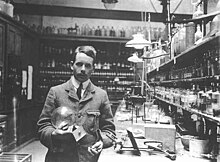Henry Moseley (physicist)
Henry Gwyn Jeffreys Moseley (born November 23, 1887 in Weymouth , † August 10, 1915 in Gallipoli ) was a British physicist . His most important scientific contribution was the proof of the correctness of the concept of ordinal numbers in chemistry .
Live and act
1906 Henry Moseley entered the Trinity College of Oxford University , a. After graduation, he worked with Ernest Rutherford at Manchester University . In his first years he was mainly occupied with teaching, after a few years he was released from teaching and began to devote himself entirely to research.
In 1913, with the help of X-ray spectroscopy, he found a systematic relationship between the wavelength and the atomic number ( Moseley's law ). Previously, it was assumed that the atomic number is an arbitrary number based on the order of the atomic masses , but must be changed (for example by Dmitri Mendeleev ) in order to put an element in the correct place in the periodic table . Moseley's discovery showed that the ordinal numbers had an experimentally measurable basis. In addition, it showed that there were gaps in numbers 43, 61 and 75 (known today as the radioactive elements technetium and promethium, and the stable but rare rhenium ). Hence, in the tradition of Mendeleev, he predicted these three elements. His work was further evidence of the atomic theory, which was still controversial at the time .
In 1914 he left Manchester to return to Oxford and continue his research there. But after the First World War broke out, he reported to the Royal Engineers . He fell at the Battle of Gallipoli near the Dardanelles on the Gallipoli peninsula .
The moon crater Moseley is named after him.
Web links
| personal data | |
|---|---|
| SURNAME | Moseley, Henry |
| ALTERNATIVE NAMES | Moseley, Henry Gwyn Jeffreys (full name) |
| BRIEF DESCRIPTION | British chemist |
| DATE OF BIRTH | November 23, 1887 |
| PLACE OF BIRTH | Weymouth |
| DATE OF DEATH | August 10, 1915 |
| Place of death | Gallipoli (Turkey) |
